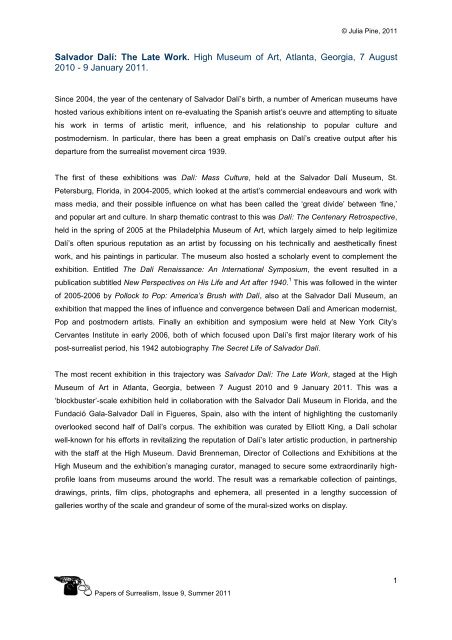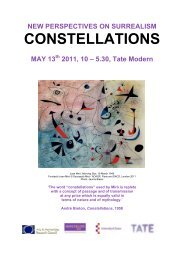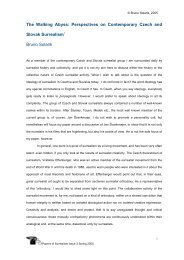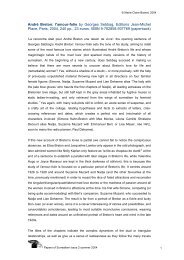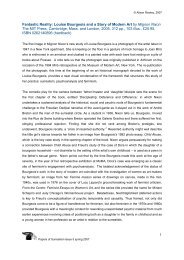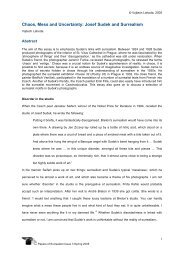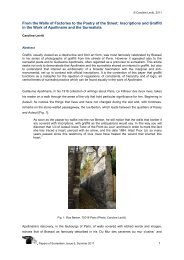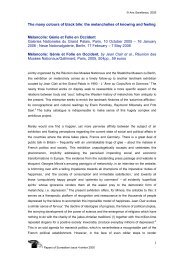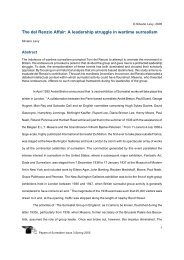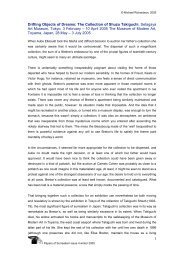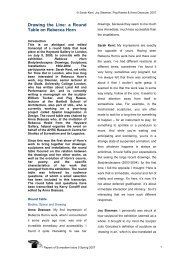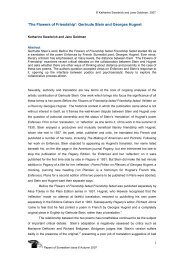Salvador Dalí: The Late Work. High Museum of Art, Atlanta, Georgia ...
Salvador Dalí: The Late Work. High Museum of Art, Atlanta, Georgia ...
Salvador Dalí: The Late Work. High Museum of Art, Atlanta, Georgia ...
You also want an ePaper? Increase the reach of your titles
YUMPU automatically turns print PDFs into web optimized ePapers that Google loves.
© Julia Pine, 2011<br />
<strong>Salvador</strong> <strong>Dalí</strong>: <strong>The</strong> <strong>Late</strong> <strong>Work</strong>. <strong>High</strong> <strong>Museum</strong> <strong>of</strong> <strong>Art</strong>, <strong>Atlanta</strong>, <strong>Georgia</strong>, 7 August<br />
2010 - 9 January 2011.<br />
Since 2004, the year <strong>of</strong> the centenary <strong>of</strong> <strong>Salvador</strong> <strong>Dalí</strong>‟s birth, a number <strong>of</strong> American museums have<br />
hosted various exhibitions intent on re-evaluating the Spanish artist‟s oeuvre and attempting to situate<br />
his work in terms <strong>of</strong> artistic merit, influence, and his relationship to popular culture and<br />
postmodernism. In particular, there has been a great emphasis on <strong>Dalí</strong>‟s creative output after his<br />
departure from the surrealist movement circa 1939.<br />
<strong>The</strong> first <strong>of</strong> these exhibitions was <strong>Dalí</strong>: Mass Culture, held at the <strong>Salvador</strong> <strong>Dalí</strong> <strong>Museum</strong>, St.<br />
Petersburg, Florida, in 2004-2005, which looked at the artist‟s commercial endeavours and work with<br />
mass media, and their possible influence on what has been called the „great divide‟ between „fine,‟<br />
and popular art and culture. In sharp thematic contrast to this was <strong>Dalí</strong>: <strong>The</strong> Centenary Retrospective,<br />
held in the spring <strong>of</strong> 2005 at the Philadelphia <strong>Museum</strong> <strong>of</strong> <strong>Art</strong>, which largely aimed to help legitimize<br />
<strong>Dalí</strong>‟s <strong>of</strong>ten spurious reputation as an artist by focussing on his technically and aesthetically finest<br />
work, and his paintings in particular. <strong>The</strong> museum also hosted a scholarly event to complement the<br />
exhibition. Entitled <strong>The</strong> <strong>Dalí</strong> Renaissance: An International Symposium, the event resulted in a<br />
publication subtitled New Perspectives on His Life and <strong>Art</strong> after 1940. 1 This was followed in the winter<br />
<strong>of</strong> 2005-2006 by Pollock to Pop: America’s Brush with <strong>Dalí</strong>, also at the <strong>Salvador</strong> <strong>Dalí</strong> <strong>Museum</strong>, an<br />
exhibition that mapped the lines <strong>of</strong> influence and convergence between <strong>Dalí</strong> and American modernist,<br />
Pop and postmodern artists. Finally an exhibition and symposium were held at New York City‟s<br />
Cervantes Institute in early 2006, both <strong>of</strong> which focused upon <strong>Dalí</strong>‟s first major literary work <strong>of</strong> his<br />
post-surrealist period, his 1942 autobiography <strong>The</strong> Secret Life <strong>of</strong> <strong>Salvador</strong> <strong>Dalí</strong>.<br />
<strong>The</strong> most recent exhibition in this trajectory was <strong>Salvador</strong> <strong>Dalí</strong>: <strong>The</strong> <strong>Late</strong> <strong>Work</strong>, staged at the <strong>High</strong><br />
<strong>Museum</strong> <strong>of</strong> <strong>Art</strong> in <strong>Atlanta</strong>, <strong>Georgia</strong>, between 7 August 2010 and 9 January 2011. This was a<br />
„blockbuster‟-scale exhibition held in collaboration with the <strong>Salvador</strong> <strong>Dalí</strong> <strong>Museum</strong> in Florida, and the<br />
Fundació Gala-<strong>Salvador</strong> <strong>Dalí</strong> in Figueres, Spain, also with the intent <strong>of</strong> highlighting the customarily<br />
overlooked second half <strong>of</strong> <strong>Dalí</strong>‟s corpus. <strong>The</strong> exhibition was curated by Elliott King, a <strong>Dalí</strong> scholar<br />
well-known for his efforts in revitalizing the reputation <strong>of</strong> <strong>Dalí</strong>‟s later artistic production, in partnership<br />
with the staff at the <strong>High</strong> <strong>Museum</strong>. David Brenneman, Director <strong>of</strong> Collections and Exhibitions at the<br />
<strong>High</strong> <strong>Museum</strong> and the exhibition‟s managing curator, managed to secure some extraordinarily highpr<strong>of</strong>ile<br />
loans from museums around the world. <strong>The</strong> result was a remarkable collection <strong>of</strong> paintings,<br />
drawings, prints, film clips, photographs and ephemera, all presented in a lengthy succession <strong>of</strong><br />
galleries worthy <strong>of</strong> the scale and grandeur <strong>of</strong> some <strong>of</strong> the mural-sized works on display.<br />
Papers <strong>of</strong> Surrealism, Issue 9, Summer 2011<br />
1
© Julia Pine, 2011<br />
Fig. 1: <strong>Salvador</strong> <strong>Dalí</strong>, <strong>The</strong> Ecumenical Council, 1960, oil on canvas, 118 x 100 inches,<br />
<strong>Salvador</strong> <strong>Dalí</strong> <strong>Museum</strong>, St. Petersburg, Florida. (Photo: <strong>The</strong> <strong>High</strong> <strong>Museum</strong> <strong>of</strong> <strong>Art</strong>, © <strong>Salvador</strong><br />
<strong>Dalí</strong>, Fundació Gala-<strong>Salvador</strong> <strong>Dalí</strong>/ARS 2010.)<br />
Compared to the previous exhibitions, this was the most comprehensive and ambitious when it comes<br />
to the re-evaluation the Spanish artist‟s work, or what has been called the „New <strong>Dalí</strong> Studies.‟ 2 Its aim<br />
was clear: to prove that <strong>Dalí</strong>‟s post-surrealist work deserves respect, and to question received notions<br />
<strong>of</strong> <strong>Dalí</strong>‟s late and commercial ventures as reductive or venal versions <strong>of</strong> his surrealist-era output. <strong>The</strong><br />
focus was on what <strong>Dalí</strong> deemed his „classic‟ paintings <strong>of</strong> the 1940s, his <strong>of</strong>ten supremely religious<br />
Nuclear Mysticism <strong>of</strong> the late 1940s and 1950s, his society portraits, and his engagement with mass<br />
culture and Pop <strong>Art</strong> in the 1960s and 1970s. Ultimately, it suggested that the creative product <strong>of</strong> the<br />
second half <strong>of</strong> <strong>Dalí</strong>‟s career has much conceptual merit and aesthetic value, that it prefigured many<br />
Papers <strong>of</strong> Surrealism, Issue 9, Summer 2011<br />
2
© Julia Pine, 2011<br />
now-current styles and media, and that it had a significant influence on the Pop <strong>Art</strong> movement,<br />
postmodernism and contemporary art.<br />
<strong>Dalí</strong>‟s „late work‟ was defined here as roughly anything post-1939, the year the artist parted ways with<br />
the surrealists after spending a decade as one <strong>of</strong> the most important members <strong>of</strong> the group. <strong>The</strong><br />
storyline was based on a chronological narrative that followed <strong>Dalí</strong>‟s painting style and subject<br />
preferences, and touched upon his work in design and his print portfolios and books, all the while<br />
attempting to position him in terms <strong>of</strong> his relationship with celebrity, mass media, popular culture and<br />
his anti-modernist directive. This narrative was told with over one hundred works <strong>of</strong> art, including<br />
forty-odd paintings and a number <strong>of</strong> drawings, prints, magazines, photographs and similar materials.<br />
While the focus was on <strong>Dalí</strong>‟s artwork, from the introductory gallery <strong>of</strong> the show, <strong>The</strong> <strong>Late</strong> <strong>Work</strong> also<br />
insisted upon the primacy <strong>of</strong> <strong>Dalí</strong>‟s personality and the artistic merit <strong>of</strong> his showmanship. It achieved<br />
this by introducing him via the lens <strong>of</strong> Philippe Halsman, the photographer with whom <strong>Dalí</strong><br />
collaborated for many years, resulting in some <strong>of</strong> the most memorable photographs <strong>of</strong> <strong>Dalí</strong>‟s career,<br />
as he twisted his famous moustache into dollar signs, flung cats into the air and arranged naked<br />
women into trompe l’oeil human skulls.<br />
Visitors were then introduced to some <strong>of</strong> <strong>Dalí</strong>‟s early paintings as a preamble and contrast to the late<br />
ones. <strong>The</strong>se included his abstract, pre-surrealist Femme Couchée <strong>of</strong> 1926, and a smattering <strong>of</strong> other<br />
works executed during his surrealist period, such as his tiny and mysterious Morphological Echo <strong>of</strong><br />
1936. Those who visited later in the calendar year were fortunate to view the exhibition when <strong>Dalí</strong>‟s<br />
most famous painting was installed, on short loan from the <strong>Museum</strong> <strong>of</strong> Modern <strong>Art</strong> in New York. This<br />
was Persistence <strong>of</strong> Memory, featuring <strong>Dalí</strong>‟s „melting watch,‟ which has remained a Dalinian<br />
trademark, not to mention a symbol <strong>of</strong> surrealism and a cultural touchstone in American art, since it<br />
was first acquired by the New York art dealer Julien Levy in 1931.<br />
By the early 1940s, <strong>Dalí</strong> formally announced that he had „become classic,‟ with the intent <strong>of</strong> turning to<br />
academic and renaissance-inspired painterly styles. An atheist up to that point, <strong>Dalí</strong> then embraced,<br />
and drew upon the subject matter <strong>of</strong> Catholicism, one <strong>of</strong> a number <strong>of</strong> things that led his former avantgarde<br />
colleagues to view him as a supporter <strong>of</strong> Spanish dictator Francisco Franco‟s <strong>of</strong>ficially Catholic<br />
regime. Once this had been established, visitors were introduced to the primary focus <strong>of</strong> the<br />
exhibition, the one-man style <strong>Dalí</strong> called Nuclear Mysticism, characterized by <strong>of</strong>ten immense<br />
canvasses featuring a mélange <strong>of</strong> <strong>Dalí</strong>‟s surrealist trademarks, religious imagery, personal<br />
iconography, and references to nuclear science and genetics. Most notable among these were a<br />
number <strong>of</strong> paintings executed in <strong>Dalí</strong>‟s meticulous 1950s-era academic style, some <strong>of</strong> which span up<br />
to thirteen feet in height, and which reference Italian renaissance religious painting. Perhaps best<br />
know among these were Christ <strong>of</strong> St. John <strong>of</strong> the Cross (1951), with its God‟s eye perspective,<br />
Assumpta Corpuscularia Lapislazulina (1952) featuring the rhinoceros horn motif and „atomically‟<br />
fragmented figuration typical <strong>of</strong> this period, and the Madonna <strong>of</strong> Port Lligat (1950), where <strong>Dalí</strong>‟s wife<br />
and muse Gala poses as the mother <strong>of</strong> Christ among a sort <strong>of</strong> deconstructed Renaissance retable.<br />
3<br />
Papers <strong>of</strong> Surrealism, Issue 9, Summer 2011
© Julia Pine, 2011<br />
Fig. 2: <strong>Salvador</strong> <strong>Dalí</strong>, Santiago El Grande, 1957, oil on canvas, 160.5 x 120 inches, collection <strong>of</strong> the<br />
Beaverbrook <strong>Art</strong> Gallery, New Brunswick, gift <strong>of</strong> the Sir James Dunn Foundation.<br />
(Photo: <strong>The</strong> <strong>High</strong> <strong>Museum</strong> <strong>of</strong> <strong>Art</strong>, © <strong>Salvador</strong> <strong>Dalí</strong>, Fundació Gala-<strong>Salvador</strong> <strong>Dalí</strong>/ARS, 2010).<br />
While exceedingly visually appealing and clearly (judging from visitors‟ reactions) awe-inspiring, the<br />
galleries dominated by these sumptuously overstated works served to underscore <strong>Dalí</strong>‟s exuberant<br />
and intentional embrace <strong>of</strong> what is perhaps best described as kitsch. This is most pronounced in<br />
works such as the roundly sentimental <strong>The</strong> Ecumenical Council <strong>of</strong> 1960 which – beneath its<br />
awkwardly-placed figures and Dalinian iconography – floats a roster <strong>of</strong> Sunday School religious<br />
images <strong>of</strong> doves, clouds, classical arches floating in the sky, and stacks <strong>of</strong> tumbling, watery clouds<br />
(Fig. 1). Likewise with the exhibition centrepiece, Santiago El Grande, featuring an astoundingly overthe-top<br />
medieval armature (referencing the geodesic domes that <strong>Dalí</strong> loved), towering behind its<br />
Papers <strong>of</strong> Surrealism, Issue 9, Summer 2011<br />
4
© Julia Pine, 2011<br />
subject, Saint James, who sits on a rearing white horse over whose private parts has conveniently<br />
wafted what might be described as a „modesty cloud‟ (Fig. 2). While proclaiming <strong>Dalí</strong>‟s reference to<br />
Italian renaissance painting, both are also exemplars <strong>of</strong> what influential American art critic and antikitsch<br />
activist Clement Greenberg described in his famous 1939 essay „Avant-garde and Kitsch,‟ as<br />
„using for raw material the debased and academicised simulacra <strong>of</strong> genuine culture.‟ 3<br />
Besides sheer bedazzlement, <strong>Dalí</strong>‟s gleeful embrace <strong>of</strong> the outré was intended, no doubt, to delight<br />
the masses and épater the champions <strong>of</strong> abstraction and geometric modernism he evidently<br />
disdained. This became even more pronounced in the following gallery, where the artist experiments<br />
with the conventions <strong>of</strong> traditional portraiture, as he does in his colourful caricature <strong>of</strong> Jack Warner,<br />
who duly sports a gleaming Hollywood grin in his portrait <strong>of</strong> 1951. Likewise in La Turbie <strong>of</strong> 1949, a<br />
rendering <strong>of</strong> the noble Sir James Dunn, who sits swathed in a glimmering classicizing sheath, while<br />
his overstated gravitas is undermined by the comical large-toothed horse carved in relief on the<br />
Roman ruins beneath him. While <strong>Dalí</strong> proved that he was soundly pr<strong>of</strong>icient in the portrait genre, he<br />
was also clearly toying with it, reconfiguring convention to create something subtly comic, highly<br />
novel, and <strong>of</strong>ten surprisingly beautiful.<br />
<strong>The</strong> <strong>Late</strong> <strong>Work</strong> was a fine testament to <strong>Dalí</strong>‟s embrace <strong>of</strong> both academicism and <strong>of</strong> „selling out‟ to<br />
commercial interests. While not unusual, and by no means unacceptable in the contemporary milieu,<br />
<strong>Dalí</strong> did this at a time when American critics and the vanguard – not to mention André Breton and<br />
what was left <strong>of</strong> the surrealist circle – largely found such transgressions galling. „All kitsch is<br />
academic, and conversely, all that‟s academic is kitsch,‟ wrote Greenberg, who included „popular,<br />
commercial art and literature‟ (i.e., popular culture) under the same rubric. 4 As King writes in the<br />
exhibition catalogue, about <strong>Dalí</strong>‟s religious paintings in particular, „one must appreciate their sheer<br />
audacity for attacking practically every artistic aspect that formalism held dear.‟ 5 <strong>The</strong> storyline <strong>of</strong> the<br />
exhibition certainly led the viewer to this conclusion, and demonstrated how <strong>Dalí</strong>‟s unabashed<br />
embrace <strong>of</strong> the academic combined with his love affair with the popular succeeded in raising bad<br />
taste to the level <strong>of</strong> high art.<br />
Plainly, <strong>Dalí</strong> welcomed and cultivated a sort <strong>of</strong> kitsch or caricatural sensibility in the fine art idiom long<br />
before it was acceptable or even understood, outside a small vanguard, as a potentially ironic or<br />
parodic posture. This was further pushed home as the exhibition moved into <strong>Dalí</strong>‟s Pop- and proto-<br />
Pop inspired work and his role in the discourses <strong>of</strong> postmodernism. <strong>The</strong>re was due emphasis here on<br />
„firstness:‟ his use <strong>of</strong> the Benday dot system in 1958 in <strong>The</strong> Sistine Madonna, executed a good few<br />
years before Roy Lichtenstein or Sigmar Polke adopted the same, and <strong>Dalí</strong>‟s dabbling in new media<br />
such as holographic art (in a work featuring rock star Alice Cooper <strong>of</strong> all people), and video art.<br />
Indeed, the screening <strong>of</strong> <strong>Dalí</strong>‟s 1960 film Chaos and Creation – cited as perhaps the first ever<br />
example <strong>of</strong> video art – outlined in no uncertain terms <strong>Dalí</strong>‟s ardent anti-modernism. In it, he sends up<br />
abstract painting, geometric abstraction and action painting using a motorcycle, popcorn,<br />
Papers <strong>of</strong> Surrealism, Issue 9, Summer 2011<br />
5
© Julia Pine, 2011<br />
Pennsylvania pigs, and a bewildered female model in a skimpy costume, all stuck in a life-size,<br />
Mondrian-inspired grid that gets splattered, via the motorcycle‟s wheels, with a sticky mess.<br />
After dazzling the visitor with <strong>Dalí</strong>‟s technical prowess, effortless interdisciplinarity, and the outsize<br />
subject matter and grandiose scale <strong>of</strong> many <strong>of</strong> his canvasses, <strong>The</strong> <strong>Late</strong> <strong>Work</strong> raised some familiar<br />
questions about evaluative criteria for art history and its slippery canon. It is certainly tempting, for<br />
example, to view America‟s recent fascination with <strong>Dalí</strong>‟s later work as an effort to recover a lost<br />
strand <strong>of</strong> American art history. Evidently, buried deep in the nation‟s collective consciousness is the<br />
memory that throughout the 1940s and 1950s, while America‟s avant-garde artists were primarily<br />
doing their abstract, expressionist, minimalist or formalist „thing,‟ <strong>Salvador</strong> <strong>Dalí</strong> was perpetually in the<br />
news with his latest frisson, performance, TV game show appearance, fashion extravaganza, society<br />
portrait, personal newsletter, jewel, or monumental Nuclear Mystical canvas. Most significantly, as the<br />
exhibition and its catalogue drove home, budding artists like Andy Warhol, Roy Lichtenstein, James<br />
Rosenquist, and later Jeff Koons, were growing up with <strong>Dalí</strong>‟s familiar figure as a recurring presence<br />
in the mass media, and making this anti-modernist renegade a model for their own highly influential<br />
work and careers.<br />
As North American art history and theory move further away from modernist paradigms largely<br />
defined by Greenbergian formalism and Breton-style ethics, the later work <strong>Dalí</strong> produced which had<br />
been quietly written <strong>of</strong>f as embarrassingly reductive, commercial and gauche, begins to look<br />
surprisingly vanguard. According to the museum press kit, King states that „where <strong>Dalí</strong> was once<br />
deliberately out <strong>of</strong> step with modern art, today we can look back on his “late” work and appreciate its<br />
innovations and antecedence to more contemporary concerns.‟ If we „move beyond <strong>Dalí</strong>‟s veneer <strong>of</strong><br />
self-promotion,‟ he continues, „or, better still, understand it as integral to his artistic project, the work<br />
can be recognized as some <strong>of</strong> the most intelligent and dynamic <strong>of</strong> the twentieth century.‟ For this very<br />
reason, in future it is quite possible that <strong>Dalí</strong>‟s later work may well come to be seen as more important<br />
and more influential than his earlier, „legitimate‟ surrealist output.<br />
Ultimately <strong>Salvador</strong> <strong>Dalí</strong>: <strong>The</strong> <strong>Late</strong> <strong>Work</strong> roundly succeeded in encouraging an appreciation for <strong>Dalí</strong>‟s<br />
post-surrealist vision, exceptional creativity and indisputable skill. Paradoxically, it also suggested that<br />
the very things that the art establishment <strong>of</strong>ten sought to dismiss in <strong>Dalí</strong>‟s post-surrealist production,<br />
such as his humour, parody, populism and commercialism, were perhaps the very ones that made<br />
him pr<strong>of</strong>oundly influential in the domain <strong>of</strong> art in the last few decades. For these reasons, and the<br />
sheer exuberance and spectacle <strong>of</strong> it all, it is most unfortunate that <strong>The</strong> <strong>Late</strong> <strong>Work</strong> was not a travelling<br />
venture, and might have enjoyed a much-deserved wider audience. For those who missed the<br />
exhibition, however, there is a very fine medium-sized catalogue produced by the <strong>High</strong> <strong>Museum</strong> in<br />
conjunction with Yale University Press. This includes one hundred and twenty one colour illustrations,<br />
and a lengthy and informative essay on <strong>Dalí</strong>‟s later work by King, as well as contributions by <strong>Dalí</strong><br />
scholars William Jeffett, Montse Aguer Teixidor and Hank Hine.<br />
Papers <strong>of</strong> Surrealism, Issue 9, Summer 2011<br />
6
© Julia Pine, 2011<br />
Julia Pine<br />
University <strong>of</strong> Essex<br />
1 Ed. Michael R. Taylor, <strong>The</strong> <strong>Dalí</strong> Renaissance: New Perspectives on His Life and <strong>Art</strong> after 1940, exh.<br />
cat., Philadelphia <strong>Museum</strong> <strong>of</strong> <strong>Art</strong>, Philadelphia and Yale University Press, New Haven and London,<br />
2008.<br />
2 Mark J. LaFountain, <strong>Dalí</strong> and Postmodernism, State <strong>of</strong> New York Press, Albany, NY, 1997, xi.<br />
3 Clement Greenberg, „Avant-garde and Kitsch,‟ in Clement Greenberg: <strong>The</strong> collected Essays and<br />
Criticism, Vol. 1, <strong>The</strong> University <strong>of</strong> Chicago Press, Chicago and London, 1986, 12. Greenberg, it<br />
should be noted, mentions <strong>Dalí</strong> in this treatise.<br />
4 Ibid.<br />
5 Ed. Elliott King, <strong>Salvador</strong> <strong>Dalí</strong>: <strong>The</strong> <strong>Late</strong> <strong>Work</strong>, exh. cat., <strong>High</strong> <strong>Museum</strong> <strong>of</strong> <strong>Art</strong>, <strong>Atlanta</strong> and Yale<br />
University Press, New Haven and London, 2010, 10.<br />
Papers <strong>of</strong> Surrealism, Issue 9, Summer 2011<br />
7


